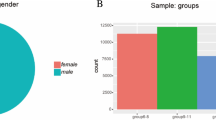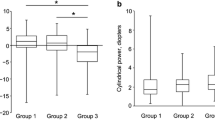Abstract
Purpose
To compare the incidence of refractive errors in Japanese patients with multiple evanescent white dot syndrome (MEWDS) with that in age- and sex-matched controls.
Methods
Fifty Japanese patients with MEWDS (11 males and 39 females; ages, 15–58; mean 29.9 years) were studied retrospectively. The refractive errors (spherical equivalent) in the patients were compared with those of 150 age- and sex-matched controls.
Results
The mean refractive error in the patient group was −5.30 ± 4.58 diopters (D) which was significantly greater than that in the controls (−2.57 ± 2.94 D, P = 0.0005). Twenty-two (44.0%) of the 50 MEWDS patients had refractive errors >−6.00 D; whereas 14 (9.3%) of 150 normal subjects had this degree of myopia. This difference was statistically significant (P < 0.005).
Conclusion
Japanese patients with MEWDS tend to be highly myopic.
Similar content being viewed by others
Author information
Authors and Affiliations
Corresponding author
About this article
Cite this article
Asano, T., Kondo, M., Kondo, N. et al. High Prevalence of Myopia in Japanese Patients with Multiple Evanescent White Dot Syndrome. Jpn J Ophthalmol 48, 486–489 (2004). https://doi.org/10.1007/s10384-004-0107-6
Received:
Accepted:
Published:
Issue Date:
DOI: https://doi.org/10.1007/s10384-004-0107-6




